Pothos houseplants are widely popular for their low maintenance, beginner-friendly growing requirements. However, it’s still possible for these vines to not thrive if they’re lacking their basic growing needs. One sign your plant isn’t thriving are its leaves turning brown.
In this guide, we’ll discuss what pothos needs to thrive and why your plant’s leaves are turning brown. We’ll also discuss how to get its care back on track.
So, if you’re struggling with this problem, don’t worry — we’ve got you covered.
What Pothos Needs to Thrive
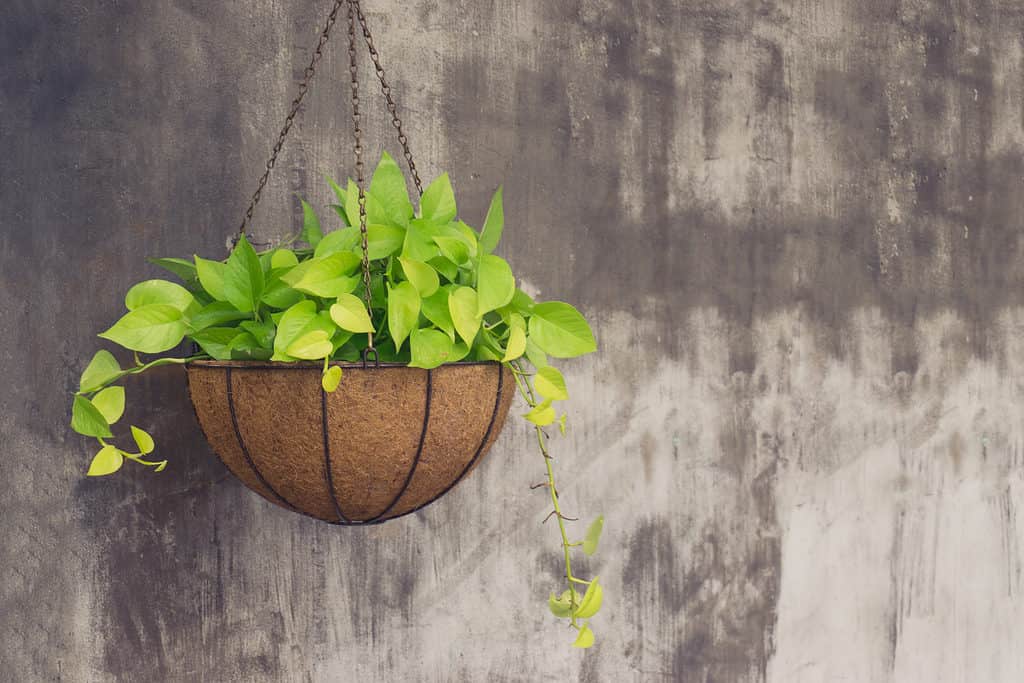
A specific set of conditions will allow your pothos plant to thrive.
©Phodsapon Longvilai/Shutterstock.com
Originating from the Solomon Islands of the South Pacific, pothos (Epipremnum aureum) is a tropical climbing vine that loves heat, medium-to-bright indirect light, humidity, and well-draining soil. Pothos can only be grown outdoors in USDA growing zones 11-12. Because of that, most people grow this lovely plant indoors, where it remains in its juvenile phase.
Now, one of the pothos’ common names is devil’s ivy. That’s because it is such a resilient plant that can tolerate a range of non-ideal growing conditions. It’s fairly drought-tolerant and can grow in less indirect lighting than it prefers. As long as the soil is not compacted, this plant can survive in most soil types that don’t lead to water pooling. While pothos loves high humidity, it does not enjoy prolongedly wet roots.
So, to recap and to go a bit more in-depth, pothos prefers the following conditions to thrive:
- Medium-to-bright indirect light
- Well-draining soil that is ideally 6.0-6.5 pH
- A warm growing environment of 70-90 degrees F
- Humidity of 50-70%
- Watering about once a week once the top 2-3 inches of the soil is completely dry.
Your plant should be entirely content if you provide pothos with these growing conditions. Since it’s known for its high resiliency, you can grow this plant somewhat outside of this range of conditions, and it will still likely grow just fine. However, if you stray too far from providing what pothos needs to thrive, you’ll start to see signs of distress, such as leaves turning brown. Below, we’ll dive into why your plant’s leaves may turn brown.
Pothos Leaves Turning Brown: Why?
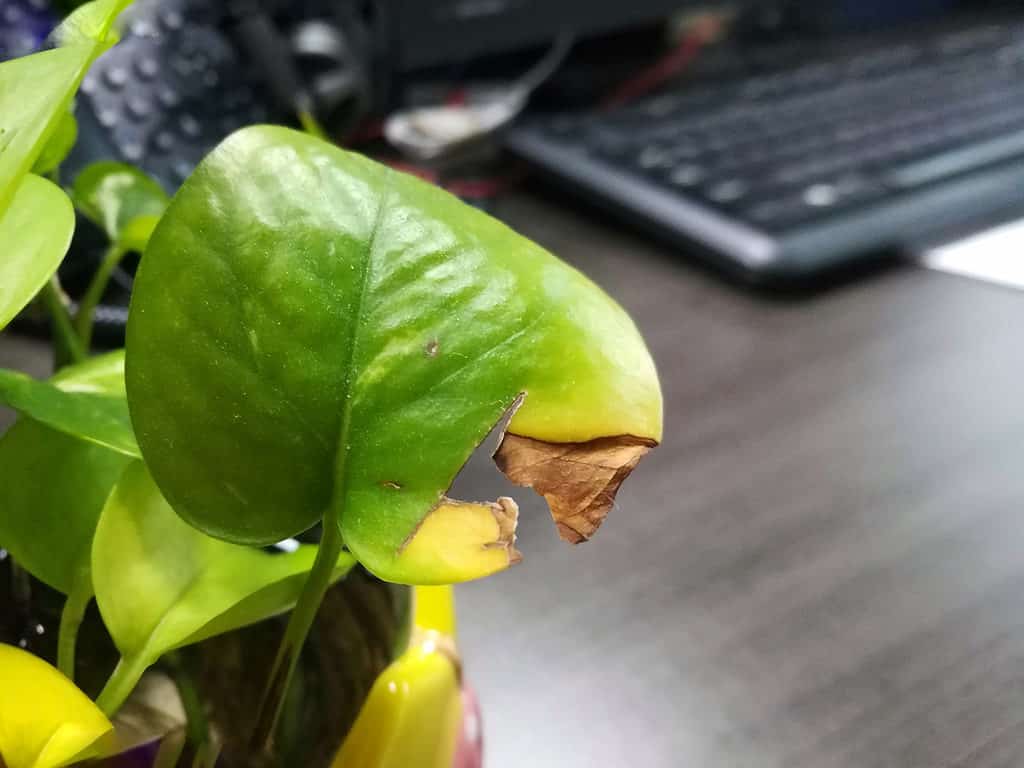
A number of reasons could be the chief cause of your browning pothos leaf.
©ukmng/Shutterstock.com
So, there are four main reasons why your pothos leaves are turning brown. They are:
- Overwatering
- Underwatering
- Sunburn
- Disease.
By thoroughly examining the plant, its growing medium and evaluating its care routine, you should be able to determine the cause of the plant’s distress. To help determine the problem, here are some questions to ask and evaluations to perform:
- Is the soil dry or wet, and how deep does the moisture or lack of moisture go into the soil?
- Are there any tiny insects or mildewy spots on the plant?
- Is the plant growing in direct sunlight?
- Are the leaves brown and crispy or brown and droopy or almost translucent?
Pothos Leaves Turning Brown: If the Soil Is Wet
So, if your pothos leaves are turning brown and your soil is consistently saturated with water, you might be overwatering your plant. While too little water will dehydrate your plant and result in brown, crispy leaves, too much water will cause the plant cells to burst and result in soft, wilted, yellow-brown leaves. While pothos is a tropical plant, it does not like getting soggy feet, so it needs to grow in well-draining soil. If your soil is too compacted, like clay, it will retain moisture and expose your pothos to root rot. Or, if your soil is well-draining, but you’re simply watering too much, the soil will not have time to dry.
How to Fix
The fix for an overwatered pothos depends on how much the plant is affected. If it appears like only a couple of leaves are turning brown, you may be able to place your plant in a dry, well-aerated space for a couple of days to allow the soil to dry. After that, ensure you’re only watering once a week when the top 2-3 inches of the soil become entirely dry.
However, if the soil has been holding on to a significant amount of moisture, the roots may be suffering from root rot. Root rot can quickly kill your plant, so you’ll need to take further action to ensure the survival of your pothos. Typically, this involves repotting your plant into a dry, well-aerated, well-draining soil medium where the roots can recover.
Pothos Leaves Turning Brown: If the Soil is Dry
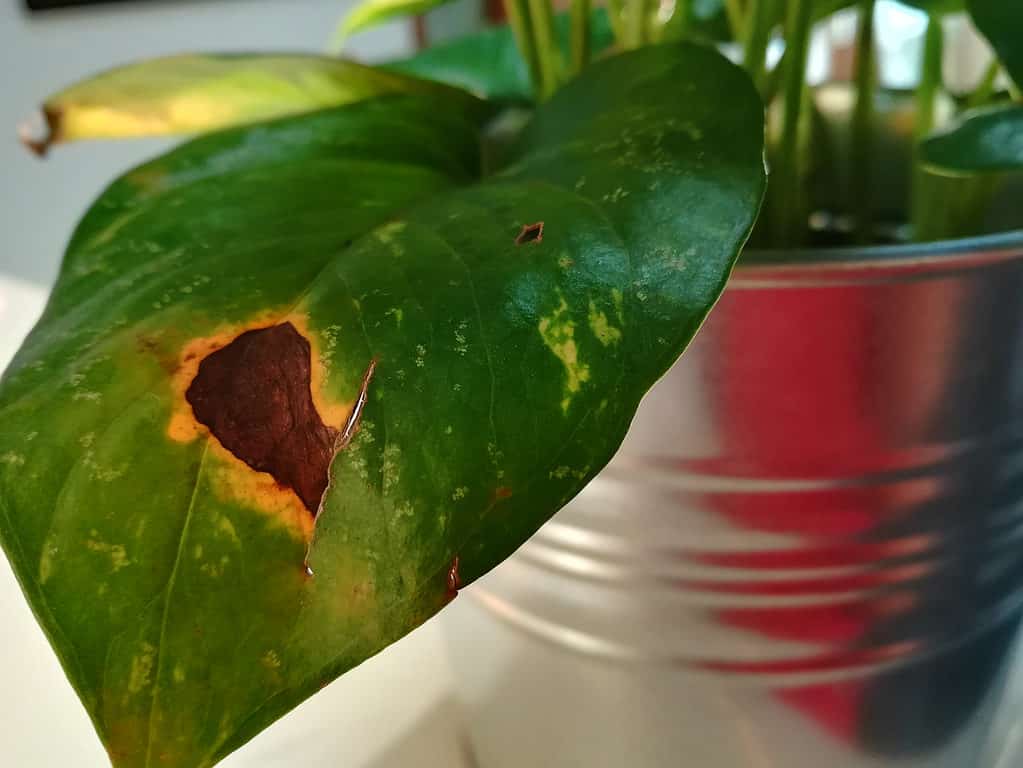
Dehydration is just one cause of a browning pothos plant.
©ukmng/Shutterstock.com
If your plant’s leaves are turning brown and the soil is notably dry, the plant may be suffering from dehydration. While pothos is fairly drought-tolerant, it’s not a desert plant and does need to be watered about once a week. Typically, you’ll want to thoroughly water this tropical vine when the top 2-3 inches of the soil is entirely dry. You can measure this with your finger or a soil moisture meter.
Plants need water for photosynthesis, to cool down, to maintain their shape, and to transport nutrients and minerals from the soil into the plant. If plants don’t receive enough water, their cells lose turgor pressure, which is the hydrostatic pressure of water in cells that gives plant tissue its shape and volume. When a plant does not receive enough water, it loses this hydrostatic pressure in its cells, and the leaves wilt. Growing in low humidity can also cause crisping leaves on pothos.
Additionally, as water is crucial to the process of photosynthesis, if the plant cells don’t contain enough water, the chlorophyll loses its ability to absorb red and blue light waves from the sun and reflect green light. As such, the leaves lose their green color and turn brown. Without moisture in the cells, the leaves feel and look crispy. Typically, the parts of the plants farthest from the roots will lose their moisture first, so you’ll see the edges of the leave first turning brown and crispy.
How to Fix
To fix an underwatered pothos plant, you’ll need to allow it the ability to drink water through its roots deeply. Because the soil will be so dry, simply pouring water at the base of your plant will mostly result in the water being sucked up by the dry soil. Instead, it’s much better to deeply water a dehydrated plant by watering it from the bottom of an aerated pot. Set the bottom of the pot into a bowl of water, and allow the plant to slowly draw water up from the bottom of the pot through its roots over 24 hours.
After this, your plant will likely feel much better, and then you’ll just need to make sure that you’re watering it enough each week. So, water only when the top 2-3 inches of the soil are completely dry, but ensure you water enough that the soil doesn’t immediately absorb all the moisture. The top of the soil should be completely saturated after watering and slowly turn entirely dry over the course of the week.
Finally, ensure the plant is growing in at least 50% humidity. If your house’s air is drier than this, try placing a small humidifier next to your plant to give it a humidity boost.
Pothos Leaves Turning Brown: If the Leaves Are Crispy and the Plant Is Growing in Direct Sunlight
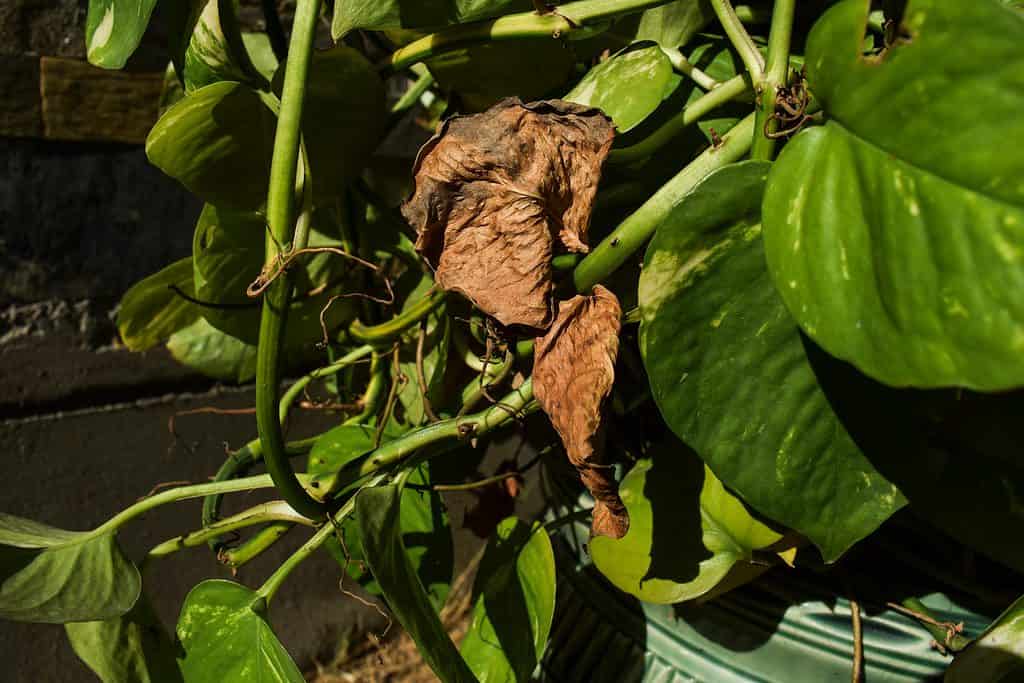
If you have a pothos leaf browning in direct sunlight, it could be getting too much sun.
©Rainbow_dazzle/Shutterstock.com
You may think this tropical, heat-loving, humidity-loving plant would thrive in direct sunlight, but it’s important to understand how this plant naturally grows. See, as a climbing tropical vine, pothos grows in the understory of large trees, thus receiving filtered sunlight. This filtered light is what your pothos needs to thrive. It can tolerate a range of filtered light from medium to bright and in general, tolerates too much shade far better than direct sunlight.
When grown in direct sunlight, the delicate leaves of your pothos plant will get sunburned. You’ll see this as the leaves develop crispy, brown spots. Typically, you can tell this apart from dehydrated leaves by the more random dotting of brown rather than the leaves turning brown from the edges and curling inward.
How to Fix
If you suspect that your pothos is getting sunburned, immediately move it away from direct sunlight and place it in an area with medium-filtered light. After a couple of days, you can choose to place the plant into a spot with bright, indirect sunlight, but make sure it’s always in indirect, not direct, sunlight. Some cultivars of pothos, such as ‘Neon,’ can lose their bright, vivid yellow-green color in too much shade, but still need to receive bright light through a filtered environment. Placing your plant in an east- or west-facing window is best for receiving bright, indirect sunlight.
Pothos Leaves Turning Brown: Disease
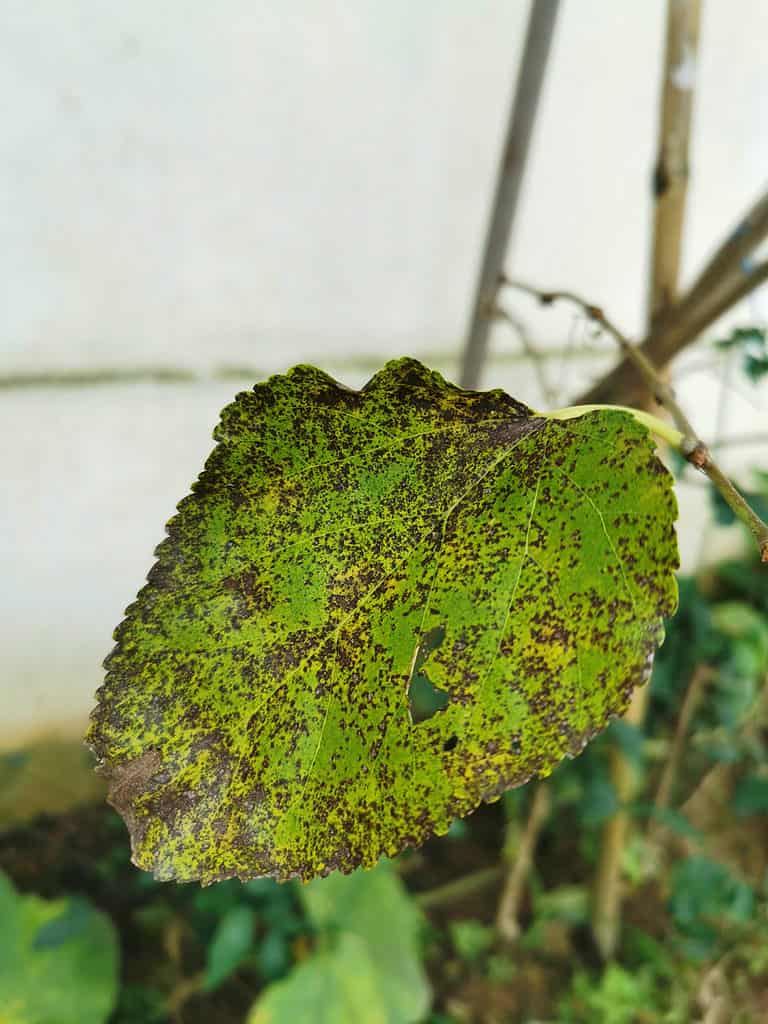
Disease is another cause of a browning pothos leaf.
©ukmng/Shutterstock.com
While generally disease-resistant, pothos can be infected by a couple of common plant diseases.
Phytophthora Root Rot
So, we already discussed one type of disease a pothos plant can regularly face: root rot from over-watering. While over-watering is the core problem, the excess of moisture in the soil breeds Phytophthora, fungi-like, pathogenic eukaryotic microorganisms called oomycetes. Phytophthora covers the roots in a slime that causes the roots to degrade.
How to Fix
Once you’ve noticed root rot, take the plant out of the infected soil, cut off any infected roots with a sterilized blade, and clean the plant with a mixture of 1-3% hydrogen peroxide to 2 parts distilled water. Replant in clean, well-aerated, well-draining soil.
Scale Bug Infection
Another disease that pothos plants can succumb to is scale bug infection. These tiny bugs attach to the mid-rib, undersides and nodes of the pothos leaves and suck nutrient-filled sap from the plant. As they thrive in arid, hot conditions, you’ll normally find these bugs on your plant if your temperature is above 70 degrees F but your humidity is less is below 50%. As the bugs deplete the plant of nutrients, the leaves begin to turn brown in spots.
How to Fix
First, quarantine the plant to prevent the infection from spreading to your other houseplants. The best way to get the population under control is through the use of an insecticide like neem oil. Spray the entire plant and gently wipe it dry. Don’t apply insecticide in sunlight, as the combination can burn your plant.
Once the infestation is notably smaller, you can often gently scrape off the remaining insects into a container to remove them from your home. Prevent re-infestation by spraying with an appropriate insecticide once per week for a month following the infection to kill any remaining larvae or hidden insects.
Pothos Leaves Turning Brown: Pruning
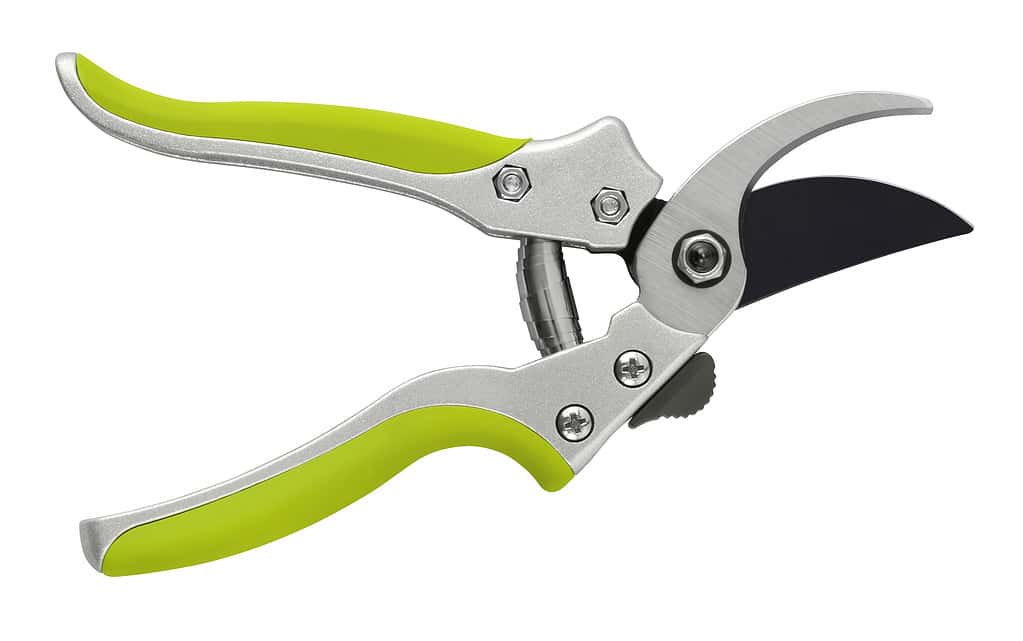
Use a clean, sharp pair of scissors or shears to prune your pothos.
©Visivasnc/ via Getty Images
We’ve now looked at the four main reasons why your pothos leaves are turning brown and dying. Regardless of whether the reason is overwatering, underwatering, sunburn, or disease, you’ll want to do one thing: prune the brown leaves as soon as you notice them.
Trimming away leaves that have turned brown or yellow, dried out, or become damaged, is an essential step to getting your plant healthy again. If the leaves are left on your pothos, the plant will still send nutrients to the dead leaves and work much harder to support growth. Removing brown leaves allows your pothos to direct energy toward new growth.
Use a clean, sharp pair of scissors or shears to prune your pothos. If more than a third of the leaf is brown or yellow, cut off the leaf close to the node, where the leaf meets the stem or the spot an aerial root could grow. If only the tip of the leaf is brown, you can snip off the dead part. If the leaf is already loose, carefully pinch it off the plant by hand.
If the damage is due to an infection, disease, or bacterial attack, remove any leaf affected as the infection could be contagious and may lead to your whole plant deteriorating. Make sure to disinfect your scissors with water and bleach or any disinfectant spray to avoid spreading the infection.
Pruning helps control a plant’s size and as an indoor pothos is capable of growing long vines of up to 10 feet regular maintenance is extra important to keep the vines at a manageable length. You can then use these cuttings for propagating a whole new plant — and start the pothos journey again!
The photo featured at the top of this post is © ukmng/Shutterstock.com
Sources
- Beauzamy, Lena; et al., Available here: https://www.ncbi.nlm.nih.gov/pmc/articles/PMC4457008/#:~:text=Plant%20cell%20growth%20depends%20on,be%20applied%20to%20small%20cells.
- University of California Agriculture & Natural Resources, Available here: https://ipm.ucanr.edu/PMG/PESTNOTES/pn74133.html
Thank you for reading! Have some feedback for us? Contact the AZ Animals editorial team.






